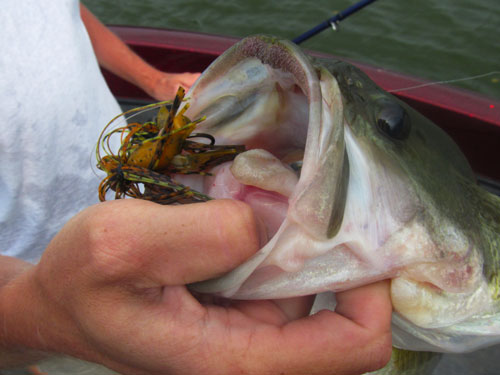BY Lee McClellan
The orange tint in the tops of mature trees portend what is coming our way. Cool nights with crisp, gorgeous days signal not only some of the best days of the year in Kentucky, but also the beginning of the fall reservoir fishing season for largemouth bass.

September is typically the driest month of the year and the water in many lakes becomes air-clear. The clear water combined with the lingering summer thermal stratification of the lake makes predator fish lethargic and skittish. This leads to tough fishing.
With the cooler night temperatures of October, the top layer of water in lakes mixes and pushes more dissolved oxygen lower in the water column. As the weather continues to cool, a bigger swath of water holds good amounts of dissolved oxygen.
“The quicker it cools off the better,” said John Williams, Southeastern Fisheries District biologist for the Kentucky Department of Fish and Wildlife Resources. “More dissolved oxygen in the depths makes the fish active again. Fall is really good for fish.”
The amount of sunlight is a more important barometer of the beginning of good fall fishing than the amount of heat left in the water. Water temperatures can vary due to early, long cold snaps, Indian summers and the like. But, the length of day never varies respective to the time of year. As fall nights lengthen and days shorten, predator fish feed.
Black bass remain close to their summer haunts until the day shortens enough to compel them into the shallows. This doesn’t happen as early as many anglers believe, but it is beginning now.
“The fish should be moving shallower now or very soon,” Williams said.
Flats become important in October and November for black bass. The section nearest the channel drop should be probed with a ¼-ounce jig in hues of brown, orange and green.
A lighter jig looks more realistic, but you’ll need to fish it more slowly than a heavier jig in early fall. Use a more subtle trailer, such as a strip of black or brown pork frog or a small crawfish imitation with pinchers, not flapping appendages.
If you don’t get any strikes on the flat, move to the channel drop and swim the jig a few feet above it. A swimming retrieve often fools lethargic bass suspended over the channel drop, a common scenario in early fall.
Gently sloping banks also make great places to swim a jig in early and mid-fall. Those comprised of mud mixed with gravel or pea gravel are best. Largemouth bass hold on these banks, often unpressured by anglers. Slowly retrieving a crawfish-colored crankbait along these banks also draws strikes.
Target main lake points and the points in creek arms nearest the main lake if flats, channel drops or sloping banks prove fruitless. Largemouth bass relate to points for the entire fall. Those comprised of mud mixed with pea gravel, small boulders and shale hold more largemouths.
Crawfish nestle in the crevices in these areas as they prepare to burrow in the mud to spend winter. A 3/8-ounce crawfish-colored jig works fantastic on these points. Employ a slow pull and drop retrieve.
Cast onto the point, allow the jig to settle on the bottom, and gently pull the rod tip up. Allow the jig to slowly fall back to the bottom and repeat as the jig works deeper down the point.
Largemouths often hit the jig on the fall. If it feels like the jig landed on a sponge, the line jumps or goes unusually slack, set the hook.
In November as the water temperatures slide toward the mid-60s, largemouths move to the bank for a week or two. This scenario is a crankbait angler’s dream as the ability to quickly cover shallow water lends a great advantage.
Boat ramps are an overlooked and highly productive spot when bass nose the banks in fall. Almost all boat ramps have a gouge hole at the end of them, stemming from water propulsion from the boat motor when trailering a boat. The flat boat ramp and the gouge hole routinely draw numbers of largemouth bass at this time of year. Boat ramps are a great early spring spot to try as well.
By Thanksgiving, largemouth bass leave the shallows and suspend near steeper drops and points where they remain for the winter. Heavy jigs crawled slowly down the point draw strikes in December. Tail spinners and blade baits allowed to shimmy down the sides of points pick off largemouths in early winter as well.
Watching college football or sitting in a tree stand draw many potential anglers away from lakes in fall. Get and enjoy the great fishing, you may have the lake practically to yourself.
Author Lee McClellan is a nationally award-winning associate editor for Kentucky Afield magazine, the official publication of the Kentucky Department of Fish and Wildlife Resources. He is a life-long hunter and angler, with a passion for smallmouth bass fishing.


Be the first to comment